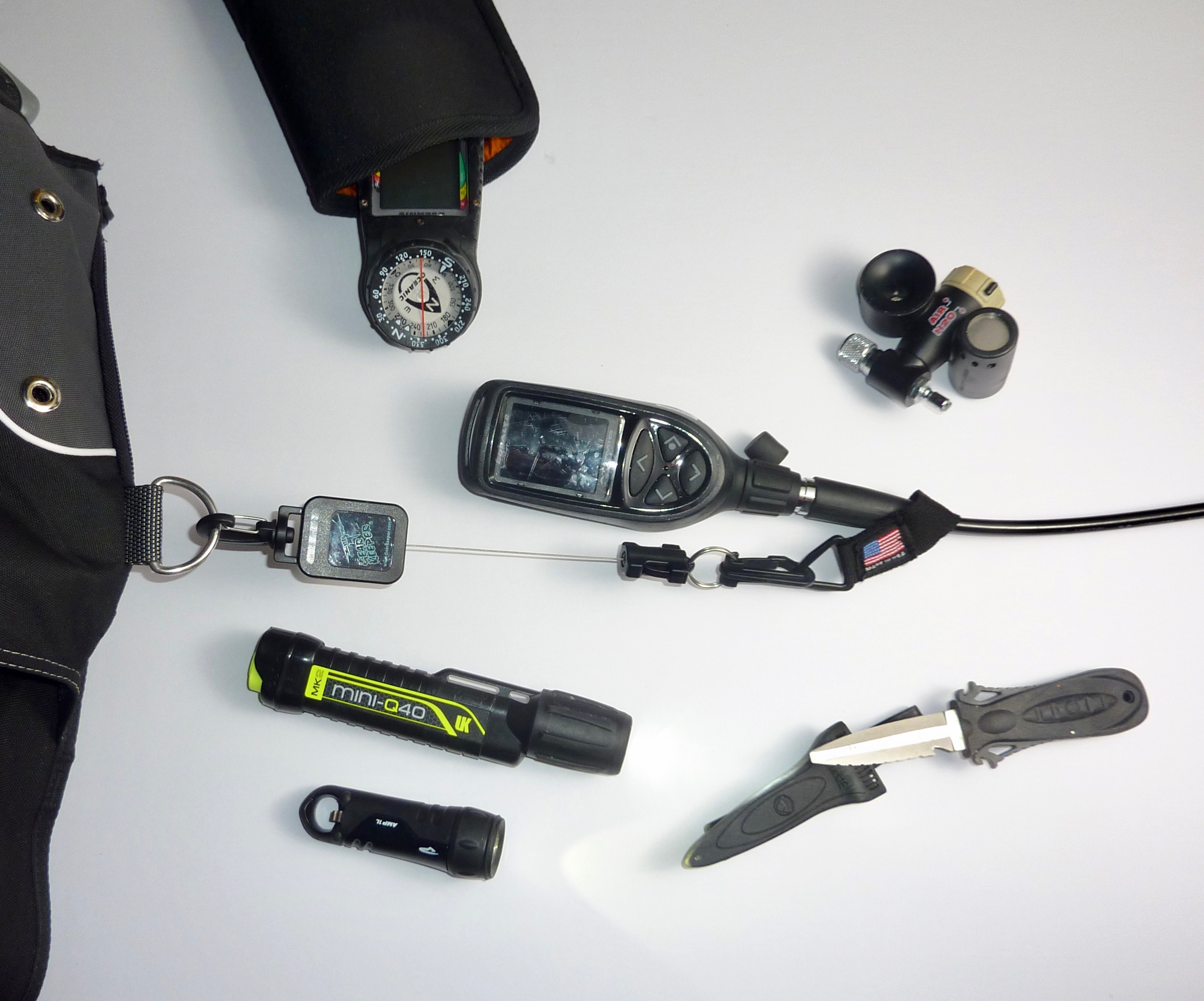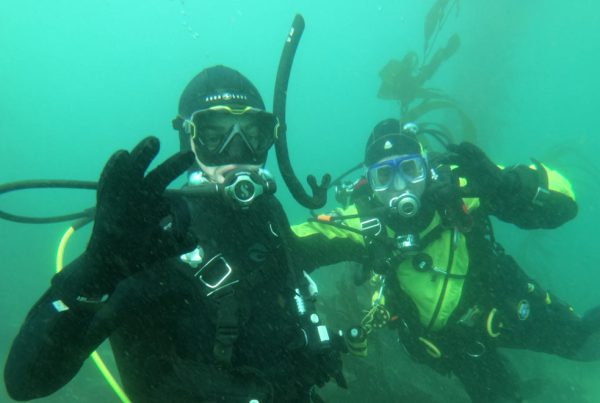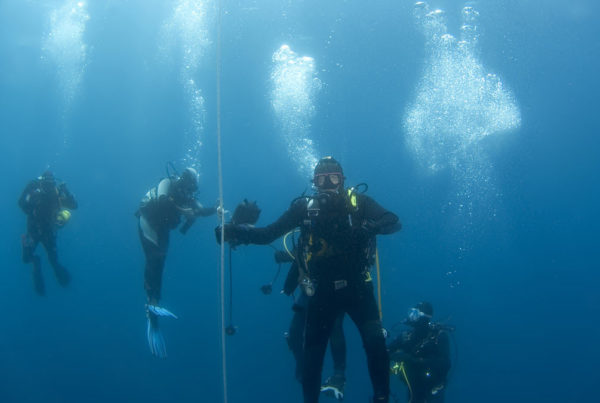 When I hit the dive center for tank fills I inevitably find myself cruising the equipment area, marveling at the display of gadgets and gizmos designed to improve my diving experience. Over the years I’ve dropped a few coins on scuba accessories, and I have to admit, only a few of these gadgets have become permanent additions to my gear bag and dive kit. The rest have ended up in the dive gear storage area of our garage, in a box labeled, “Misc. Dive Gear.”
When I hit the dive center for tank fills I inevitably find myself cruising the equipment area, marveling at the display of gadgets and gizmos designed to improve my diving experience. Over the years I’ve dropped a few coins on scuba accessories, and I have to admit, only a few of these gadgets have become permanent additions to my gear bag and dive kit. The rest have ended up in the dive gear storage area of our garage, in a box labeled, “Misc. Dive Gear.”
I decided it’s time to declutter my dive gear collection. I’m not a devotee of Japanese tidying-up expert Marie Kondo or anything – I don’t expect my life to be transformed by cleaning the garage – but I know it’ll feel good to free up some storage space and have my dive gear and accessories better organized. And you’ll enjoy a side bennie of my cleaning spree, too, as I’ve decided to share my “must have” list of dive gear accessories here.
Surface marker buoy. First on my list is a big, bright inflatable safety sausage, which is also called a surface marker buoy or SMB. A diver floating at the surface can be difficult to spot without one. You owe it to yourself, your buddy, your loved ones – and the boat crew – to carry a safety sausage on every dive. I have used mine more than I have used my dive knife. It is a must for signaling not just in current or isolation but also in an emergency on beach dives or even during a lake dive.
I have one with a pocket on the underwater end for a line and small weight. I keep 15 feet of line in the pocket with the sausage on one end and the weight on the other. It makes a great safety stop buoy. It lets me signal my location to the boat crew before I surface, so I spend less time bobbing at the surface waiting to be picked up. This model also has a clear sleeve at the top for a chemical glow stick, and a grommet for attaching a strobe, yet it’s still compact enough to fit inside my buoyancy compensator (BC) pocket.
Personal locator beacon. Here I’m referring to my Nautilus Lifeline Marine Rescue Global Positioning (GPS) unit. Although I’ve never had to actually use this compact but high-tech emergency-signaling device, it gives me peace of mind to know that I have it. It’s small enough to fit in a BC pocket. In the event of a “missing diver” situation, you can use the PLB to relay your position to nearby boats and emergency personnel.
Audible signaling device. This can be a simple low-tech whistle that you blow into when on the surface, or a sophisticated DiveAlertPlus2™ device that emits sound both at the surface and underwater. On the surface, the sound has reportedly been heard from a distance of more than a mile.
Cutting tools. We used to joke that the reason divers carry big knives strapped to their legs is so that if they see a shark approaching they can stab their buddy and swim away! I know, bad joke. And as much as I admit my fondness for the big commando-style dive knives of old, the smaller ones now on the market are pretty cool. I have one made of titanium that’s nearly indestructible, with a super-sharp blade and a serrated edge, too. Instead of strapping it to my leg, it’s small enough to attach to my BC and has a quick-release sheath designed for easy, one-handed use.
Line cutters and EMT shears also make my list of must-haves, especially for those who are diving in areas that might have a lot of monofilament line.
In recent years it seems dive knives have become viewed as optional accessories. I think this is wrong. Every diver should carry a cutting tool suited to cut through a variety of entanglement hazards, including fishing line, rope and kelp.
Dive lights. Even if you’re not into night diving, every diver should carry at least a small dive light. These compact, inexpensive lights fit into a BC pocket and are useful for exploring cracks and crevices where small, colorful creatures reside. If you are into night diving you’ll want a bigger light and a medium-sized backup light. Great advances in lighting technology have been made in recent years. If it’s been a while since you checked out the lighting options now available for divers, ask the people at your dive center. You’re in for a treat. Ask about headlamps that allow hands-free lighting. And ask about marker strobes, too. Like I said, new technology. There are some pretty cool lighting options out there.
Straps and springs and snag-preventers. We all know it’s important to secure our gear and streamline our equipment to avoid entanglement and also protect the delicate underwater environment. But did you know that there are a bunch of really nifty gadgets designed to help you achieve this?
One of the worst culprits when it comes to kelp entanglement is a loose fin strap. Put spring straps on your shopping list. They eliminate four possible snag points and make it easier to slip fins on and off. And because they provide a snug fit they’re comfortable to wear and lessen the likelihood that you’ll accidentally lose a fin. They are relatively simple to install on most fin styles, so I urge you to switch out your old-school straps for springs. You’ll be glad you did.
When it comes to accessory items for securing and streamlining your gear, your dive center has lots of options, from lanyards to retractable gauge clips and specially designed retainers for your safe-second regulator and gauge console. Go over these options with a gear specialist who can help you select the accessories that are right for you and the type of diving you do.
A slate. There’s nothing particularly exciting about the simple dive slate. But it can really come in handy when you need to communicate more than an “OK” signal to your buddy.
Marking tools. It is not unusual that you could be on a boat with another diver with an identical set of fins, mask or even BC. That happened recently with a new pair of fins I hadn’t marked. Turns out, another diver (who also hadn’t marked his gear) had an identical pair. You can guess what happened. We got it sorted, but marking your dive gear prevents this type of confusion. And it can help prevent theft, too. Thieves are less likely to make off with gear that has your name or initials on it. There are a lot of inexpensive accessories you can use to mark your gear, including waterproof paint markers, stickers, tags and etching tools. Protect your investment by putting your mark on your gear.
Dive bags. A good dive bag (or two or three) is a must for organizing and transporting your gear. If you’re like me, you’ll collect several of different sizes and styles for a variety of uses. For airport travel, you might opt for a heavy-duty, wheeled bag with dual zippers that you can secure with a lock. But that’s overkill when on local charters, especially when you consider that most dive boats simply do not have the space for bulky rolling bags, trunks or hard-sided containers. A bag that at least partially collapses for storage is a wise choice. You’ll probably also want to have a mesh duffel for storing dive gear and accessories on the dive deck, and a waterproof dry bag for storing your phone, wallet and other stuff you don’t want getting soaked. Lastly, if you’re a hunter you’ll need a game bag for collecting bugs and stuff.
Gloves. And a hood. Gloves are an important accessory when the water’s chilly or when you are hunting, to keep your hands warm and prevent scrapes. But here’s a fun trick: get an extra large pair of orange or red garden gloves to wear over your regular gloves. Waving the red gloves at a Garibaldi usually drives them nuts and they’ll put on quite a show. I’ve used the glove trick to get some great portrait shots.
As for wearing a properly fitting hood, it’s a popular myth that we lose over half our body heat through the head. Even though that isn’t true, you probably already know the benefits of staying comfortable on a dive. I’ll also add that the windproof, hooded “boat coat” – while not actually a piece of dive gear – is a worth-it’s-weight-in-gold accessory. You can put it on over your wet suit or dry suit in between dives.
So, this completes my must-have dive gear and gadgets list.
And now, here are a couple “just for fun” gadgets.
A mirror. A mirror is just plain fun for playing with fish. Certain kinds of California fish will confront and even bite the mirror if they feel their territory is being invaded. Famous for defending their little section of the ocean are Garibaldi, the California State Marine Fish. Their territorially is seasonal, usually spring through early fall when nesting. When presented with a mirror image of itself the Garibaldi will move in, popping their jaw, head down and sometimes bite at their own reflection. Other confrontational fish species include the sheephead, sarcastic fringehead and occasionally the painted greenling.
Obviously it is a bad idea to carry around a glass mirror in your BC pocket. Find a plastic or stainless steel mirror. As a side bonus you can use a mirror as a surface-signaling device.
Fishing lures. This is one gadget you will not find in my dive bag (yet) but it deserves mentioning. This is a pretty whacky idea but it actually works. It consists of a hookless fishing lure usually attached to a small pole by a short section of monofilament fishing line. They are originally born of the spearfishing community. Big ones for spearfishing can be purchased or you can make smaller ones yourself. Try smaller lures first for smaller species of fish. With these you can attract in some fish, and perhaps observe some unusual behaviors.
A Decluttered Conclusion
Now that I’ve gone through the “Misc. Dive Gear” box and weeded out some old, worn, or just plain never-gonna-use gadgets, I do feel just a touch of that light, joyful feeling Marie Kondo is making fortunes promoting. And I’m more organized than before, which will simplify my pre-dive packing. And who am I kidding? It also makes room for more cool gadgets and gizmos I’ll probably buy the next time I’m at the dive store.









